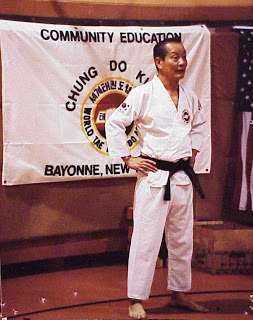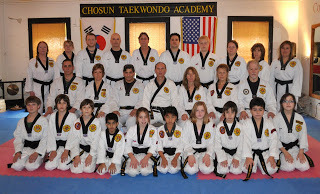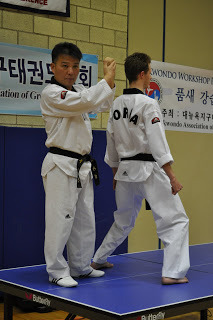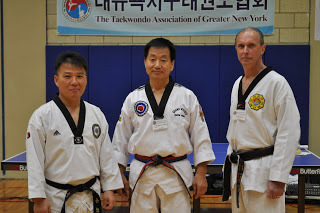Doug Cook's Blog, page 36
September 5, 2011
Chosun e-newsletter archive Volumn 2 #1 January, 2011
Dear Martial Arts Enthusiast,
Welcome to 2011 and the fourth edition of the Chosun e-newsletter. As Chosun Taekwondo Academy enters its 14th year of operation, we celebrate the continued vitality of our school and look ahead to recognizing the ever present opportunities that strengthen our intentions and rejuvenate our spirit! The five tenets, recited at the end of every taekwondo class are a way to re-connect to universal respect and order that stand at the root of every culture and spiritual tradition through the millennia. This continuum helps us as individuals and in turn our larger Chosun family to achieve our objectives and seek common purpose. We value your support and wish you a productive and prosperous new year!
Read entire newsletter
Welcome to 2011 and the fourth edition of the Chosun e-newsletter. As Chosun Taekwondo Academy enters its 14th year of operation, we celebrate the continued vitality of our school and look ahead to recognizing the ever present opportunities that strengthen our intentions and rejuvenate our spirit! The five tenets, recited at the end of every taekwondo class are a way to re-connect to universal respect and order that stand at the root of every culture and spiritual tradition through the millennia. This continuum helps us as individuals and in turn our larger Chosun family to achieve our objectives and seek common purpose. We value your support and wish you a productive and prosperous new year!
Read entire newsletter
Published on September 05, 2011 09:20
Chosun e-newsletter archive Volumn 1 #3 December 2010
Dear Martial Arts Enthusiast,
Welcome to the third edition of the Chosun e-newsletter. As the final days of the year rush by, and a new year waits in the wings, we as students of Chosun can count our blessings and take pride in the many accomplishments and achievements of the past year. As a school, Chosun has added 24 new black belts to its ranks and provided an opportunity for students to deepen their training experience by traveling to Korea, the birthplace of Taekwondo. Through the efforts of the Leadership Team, young students have been able to put the five tenets of Taekwondo into practice. So while the Chosun Taekwondo Academy is a place where our commitment to the art flourishes, we as individuals must find the courage, stamina and confidence to carry our commitment into action every day. Grandmaster Richard Chun sums it up with his few but meaningful words, "Never Give Up."
Read entire newsletter
Welcome to the third edition of the Chosun e-newsletter. As the final days of the year rush by, and a new year waits in the wings, we as students of Chosun can count our blessings and take pride in the many accomplishments and achievements of the past year. As a school, Chosun has added 24 new black belts to its ranks and provided an opportunity for students to deepen their training experience by traveling to Korea, the birthplace of Taekwondo. Through the efforts of the Leadership Team, young students have been able to put the five tenets of Taekwondo into practice. So while the Chosun Taekwondo Academy is a place where our commitment to the art flourishes, we as individuals must find the courage, stamina and confidence to carry our commitment into action every day. Grandmaster Richard Chun sums it up with his few but meaningful words, "Never Give Up."
Read entire newsletter
Published on September 05, 2011 09:01
September 2, 2011
Chosun e-newsletter archives Volumn 1 #2 November 2010
Dear Martial Arts Enthusiast, Welcome to the second edition of the Chosun e-newsletter. The Chosun Taekwondo Academy wants to extend and invitation to you and your family to attend our:
13th Annual Awards Banquet
& Dinner Dance
Saturday December 11th, 2010 6:30 - 11:00 pm
Black Bear Golf Club, 138 Route 23 North, Franklin, NJ 07416
Guest of honor Grandmaster Richard Chun, DJ and dancing, cash bar, awards presentation, and a visit from Santa!
Adults: $49 / Children:$39 / under 4 years: FREE Make checks payable to Chosun Taekwondo Academy. Remit to Chosun Taekwondo Academy PO Box 721 Warwick, NY 10990 Reserved seating available: contact Chosun at info@chosuntkd.com
Kamsahamnida, Patty Cook, Editor
Celebrate the season and your dedication to the traditional martial art of Taekwondo. Happy Thanksgiving!
Read the entire newsletter
13th Annual Awards Banquet
& Dinner Dance
Saturday December 11th, 2010 6:30 - 11:00 pm
Black Bear Golf Club, 138 Route 23 North, Franklin, NJ 07416
Guest of honor Grandmaster Richard Chun, DJ and dancing, cash bar, awards presentation, and a visit from Santa!
Adults: $49 / Children:$39 / under 4 years: FREE Make checks payable to Chosun Taekwondo Academy. Remit to Chosun Taekwondo Academy PO Box 721 Warwick, NY 10990 Reserved seating available: contact Chosun at info@chosuntkd.com
Kamsahamnida, Patty Cook, Editor
Celebrate the season and your dedication to the traditional martial art of Taekwondo. Happy Thanksgiving!
Read the entire newsletter
Published on September 02, 2011 13:14
Chosun e-newsletter archives Volumn 1 #1 October 2010
Dear Martial Art enthusiast,
Thank you for your interest in the Chosun Taekwondo Academy and the traditional martial art of Taekwondo. In this inaugural issue of our newsletter you will find information on news and events at our academy as well as insights into the training experience at the Chosun Taekwondo Academy. As a newsletter recipient you will receive notification about Chosun sponsored events such as Taekwondo trips and seminars as well as previews of upcoming books and articles written by Master Doug Cook.
Kamsahamnida and Thank you for your support
Patty Cook, Editor
Read entire newsletter
Thank you for your interest in the Chosun Taekwondo Academy and the traditional martial art of Taekwondo. In this inaugural issue of our newsletter you will find information on news and events at our academy as well as insights into the training experience at the Chosun Taekwondo Academy. As a newsletter recipient you will receive notification about Chosun sponsored events such as Taekwondo trips and seminars as well as previews of upcoming books and articles written by Master Doug Cook.
Kamsahamnida and Thank you for your support
Patty Cook, Editor
Read entire newsletter
Published on September 02, 2011 06:18
April 14, 2011
A TAEKWONDO LEGEND PASSES...Grandmaster Sung Duk Son

Grand Master Duk Sung Son, 88, of Newport, RI died March 29, 2011 at Newport Hospital. His funeral was held on April 4. Donations in his memory may be made to the Alzheimer's Association, 245 Waterman Street, Suite 306, Providence, RI 02906.
Grandmaster Son began studying Tae Kwon Do in the 1940's under the leadership of Won Kuk Lee in Korea. Won Kuk Lee was the founder of the Chung Do Kwan (school of the Blue Wave). Grandmaster Son quickly rose to the black belt level and onward to the master level and assumed the leadership of the Chung Do Kwan in 1950. In 1955, Grandmaster Choi, Son and other leading Korean martial arts masters gathered together and originated the name Tae Kwon Do for the Korean national martial art.
In 1963 Grandmaster Son and several of the Chung Do Kwan institute masters (J.B. Chung, and N.Y. Chung among them) came to the United States. Then in 1966 Grandmaster Son united the Chung Do Kwan masters under the World Tae Kwon Do Association (WTA). While in the United States Grandmaster Son has taught at West Point, Yale, Pricenton, Brown, Columbia, New York University, Fordham, Stony Brook, and Providence. Fordham gave him an honorary Professorship. And he has also taught employee's of major corporations IBM and Chase Manhattan Bank. In 1965 Grandmaster Son recieved the Medal of Honor from President Park of South Korea. Major General John B. Conaway, director of the Air National Guard Bureau in Washington D.C. made Grandmaster Son an Honorary General. Omni magazine did an article on the top five U.S. Martial Arts Masters and listed Grandmaster Son as among them. Grandmaster Son retired in 2009.
The above information wa sgathered from Stark's Taekwondo of Augusta, GA. We thank you for this worthy tribute.
Published on April 14, 2011 17:33
A TAEKWONDO LEGEND PASSES...Grandmaster Son Duk Sung

Grand Master Duk Sung Son, 88, of Newport, RI died March 29, 2011 at Newport Hospital. His funeral was held on April 4. Donations in his memory may be made to the Alzheimer's Association, 245 Waterman Street, Suite 306, Providence, RI 02906.
Grandmaster Son began studying Tae Kwon Do in the 1940's under the leadership of Won Kuk Lee in Korea. Won Kuk Lee was the founder of the Chung Do Kwan (school of the Blue Wave). Grandmaster Son quickly rose to the black belt level and onward to the master level and assumed the leadership of the Chung Do Kwan in 1950. In 1955, Grandmaster Choi, Son and other leading Korean martial arts masters gathered together and originated the name Tae Kwon Do for the Korean national martial art.
In 1963 Grandmaster Son and several of the Chung Do Kwan institute masters (J.B. Chung, and N.Y. Chung among them) came to the United States. Then in 1966 Grandmaster Son united the Chung Do Kwan masters under the World Tae Kwon Do Association (WTA). While in the United States Grandmaster Son has taught at West Point, Yale, Pricenton, Brown, Columbia, New York University, Fordham, Stony Brook, and Providence. Fordham gave him an honorary Professorship. And he has also taught employee's of major corporations IBM and Chase Manhattan Bank. In 1965 Grandmaster Son recieved the Medal of Honor from President Park of South Korea. Major General John B. Conaway, director of the Air National Guard Bureau in Washington D.C. made Grandmaster Son an Honorary General. Omni magazine did an article on the top five U.S. Martial Arts Masters and listed Grandmaster Son as among them. Grandmaster Son retired in 2009.
The above information wa sgathered from Stark's Taekwondo of Augusta, GA. We thank you for this worthy tribute.
Published on April 14, 2011 17:33
April 9, 2011
DISCIPLINE AND COMMITMENT

DISCIPLINE AND COMMITMENT...standards of the martial artist when the soft breeze of spring beckons, tempting the mind and body with reprieve rather than focused training. Taekwondo is a kind mistress but will not long pardon inattention. Reestablish your center.
Published on April 09, 2011 14:21
December 21, 2010
REINTRODUCTION TO ORIGINAL KORYO POOMSAE

While most people were nestled all snug in their beds, a small but dedicated group of CHOSUN TAEKWONDO ACADEMY black belts were introduced to modifications in the Original Koryo poomsae by Master Doug Cook at their Sunday morning Black Belt Class on December 19, 2010. The poomsae will be detailed in an upcoming book authored by Master Cook and Grandmaster Richard Chun and published by YMAA of Boston. Originally created in the mid 1960s along with the remaining eight Yudanja series forms, Original Koryo has become a "hidden poomsae", rarely taught at dojangs around the world. This formal exercise which was replaced by the existing Koryo poomsae in the early 1970s, has fortunately been preserved by Grandmaster Richard Chun and transmitted to his students through the United States Taekwondo Association. The CHOSUN students are the first recipients of these significant modifications in Original Koryo which were executed in the name of standardization.
Published on December 21, 2010 17:32
October 9, 2010
CHOSUN ATTENDS POOMSAE SEMINAR WITH GRANDMASTER JEON BEOM PARK


POOMSAE SEMINAR WITH GRANDMASTER JANG BEOM PARK, KUKKIWON
The poomsae seminar held at Queensborough Community College on Sunday, October 3, 2010 was a highly interesting and rewarding experience. Many new variations in techniques were described in detail by Kukkiwon Grandmaster Jeon Beom Park. Representing Chosun were Master Cook, Instructor Lisa Ehrenreich and Ms. Marcele Mitscherlich. The seminar focused primarily on Taegeuk poomsae as well as the first four Yudanja series formal exercises including Koryo, Keumgang, Taebaek and Pyongwon. The operational word during the seminar was "CHANGE". It was made clear that alterations in poomsae were being made in the name of standardization and not for self-defense purposes. This was a welcome revelation that clearly distinguishes the practice of poomsae into two catagories, that of sport and tradititional, practical solo defensive practice.The seminar was sponsored by the Taekwondo Association of Greater New York.
Published on October 09, 2010 16:19
April 4, 2010
CHANGE UNLOOKED FOR

Recently, my daughter Erin completed a 200-hour instructor training course at the Kripalu Yoga Center located in Lenox, Massachusetts. My wife Patty and I went to pick her up one beautiful, autumn day and while walking up a stairway I noticed a poster on a wall. In it was a photo of a woman sitting on a bus with a caption reading: "I was only trying to get home from work."
For those of us old enough to remember, the precipitous event that produced this antiquated photograph represented a world of change. On December 1, 1955, in segregated Montgomery, Alabama, after a long, hard day at work, a seamstress named Rosa Parks headed homeward. Dog tired, she took a seat in the front section of a city bus. After a few stops, the bus driver demanded that she give up her seat to a man of European descent. She refused. Shortly after, she was arrested, convicted of disorderly conduct and subsequently, lost her job. The response of one woman to this unreasonable command inspired the 381-day Montgomery Bus Boycott. Ultimately, it helped end segregation in Alabama and is a testament to the fact that the actions of one person can have a profound effect on the fabric of humanity at large. Later, when interviewed, Ms. Parks said: "I was only trying to get home from work." Rosa Parks literally changed the complexion of racial discrimination in America without any premeditated intent whatsoever.
Today, as martial artists, as modern warriors endowed with an ancient wisdom, we endeavor, by example, to live a life of virtue as dictated by the Five Tenets of Tae Kwon Do: Courtesy, Integrity, Perseverance, Self-Control and Indomitable Spirit. We set our sights not on elusive perfection, but on a path to excellence both physically and ethically. As living vessels of these moral principles, we possess the power to influence change for the better whether it be at work, at home or in school. Yet, when we awake in the morning, just as Rosa Parks did one December day in 1955, we never know where our daily path will take us.
During a recent promotion test at my school, the Chosun Taekwondo Academy, a ten-year old girl rose to read her required essay on the topic of indomitable will. By the conclusion of her reading, there was not a dry eye in the audience. I feel it is safe to say that not many adults could have annunciated this virtue as well as this child did. She is small; a little wisp of a thing, yet she spoke of her confidence and how, regardless of how her peers might attempt to discourage her, she would diligently press ahead with her adolescent dreams and, eventually, with those that will flesh out her adult life. Both she and her parents attributed this sense of self-assurance directly to her tae kwon do training. Who's to say what this youngster might accomplish in the decades ahead? Might she one day change the world simply by returning home from school or work?
Fortunately for us today, the great martial arts masters of the past chose to imbue their hard-earned disciplines, no longer as viable in a world of advanced weaponry, with meritorious codes of honor in an effort to survive cultural upheaval within their society. Evidence of this trend manifested itself in the creation of Funakoshi's karate-do and Kano's judo. Rather than teaching techniques primarily intended to devastate an enemy on the field of battle, elementary and college level students attending schools in Okinawa and Japan, particularly during the early 20th century, were exposed to martial arts training as a vehicle for physical fitness and character enhancement. Later, following the liberation from Japanese imperialism that coincided with the conclusion of the World War II, Korean masters returned to their native land, continuing this tradition. We, as tae kwon doists of the new millennium are the recipients this time-honored practice. Granted, practical tae kwon do was initially developed as a form of self-defense for soldiers in the theatre of combat. However, by recognizing the necessity for an ethical framework intended to govern and balance the destructive power we as martial artists possess, our predecessors fashioned an environment where altruism trumps apathy. By way of example, the Chosun Taekwondo Academy Leadership Team, a group of active, young students whose mission it is to serve our local community under the direction of black belts Cheryl Crouchen and Mary Suleski, recently raised a large amount of revenue for the Lions Club International and provided Christmas gifts for underprivileged children. Likewise, I continuously attempt to gainfully influence fellow martial artists of all ages and creeds, by teaching with integrity and by sharing my knowledge of tae kwon do, globally, through the books and articles I have written.
Nevertheless, I am certain that my students are not unique in their pursuit of virtue through the practice of traditional tae kwon do even though our comprehensive curriculum clearly emphasizes the philosophical elements of the art. Many of the schools I have visited across America can easily boast of members equally as devoted to leaving a positive stamp on their communities. Yet, regardless of the source, it is often the deed that occurs unlooked for that resonates most through humankind at large just as in the case of Rosa Parks or my young student who stands ready to affect a climate of benevolence whenever necessary. Given the blueprint set down by previous generations of masters and grandmasters, the important work of cultivating an elevated lifestyle wrapped in virtue becomes less a chore and more a gratifying reward. Therefore, as martial artists of the 21st century, we must strive for ethical consistency through the disciplined, virtuous practice of tae kwon do so that if called upon by fate, we will be prepared to manifest positive change anywhere, anytime or anyplace, as best we can…even if we are just trying to get home from work.
Published on April 04, 2010 17:09



